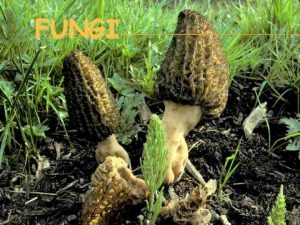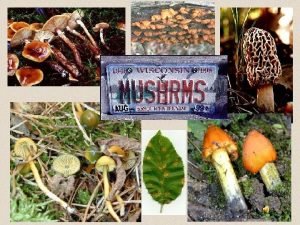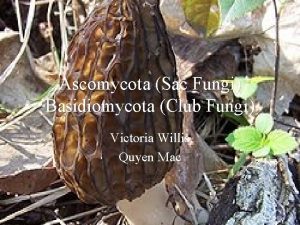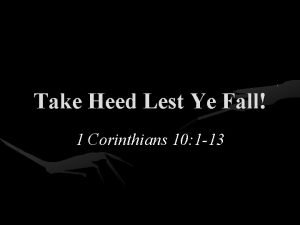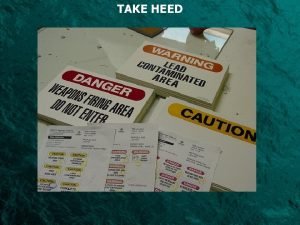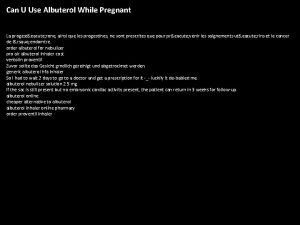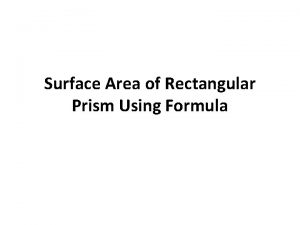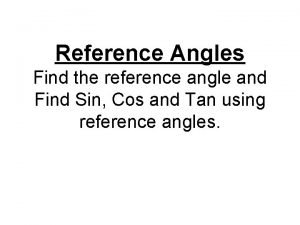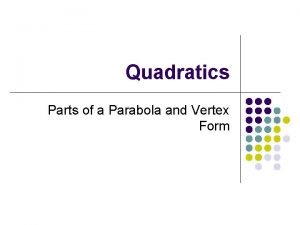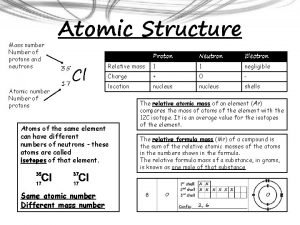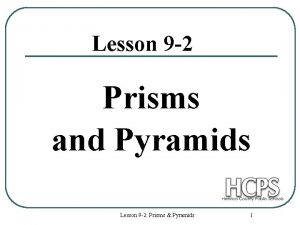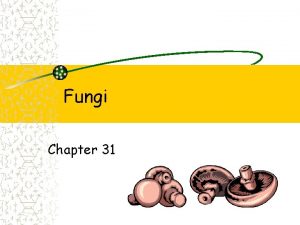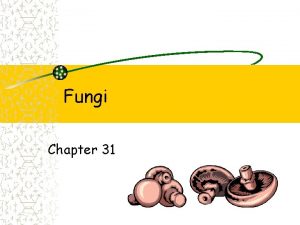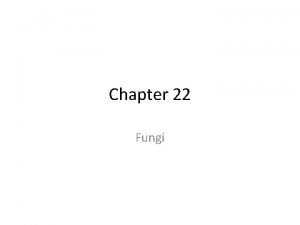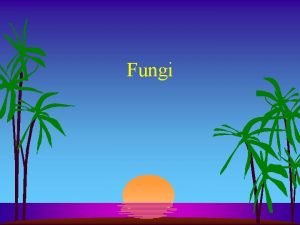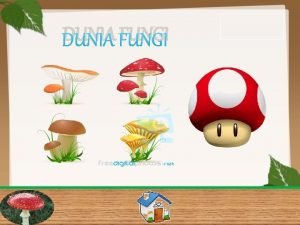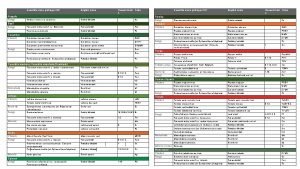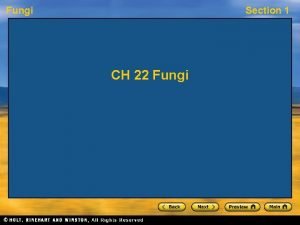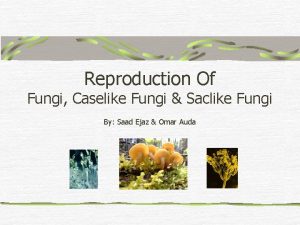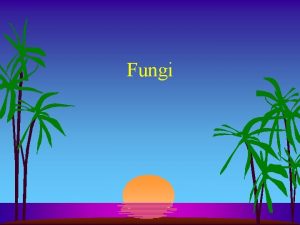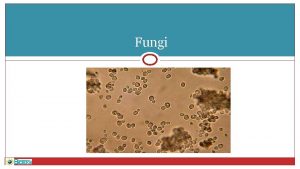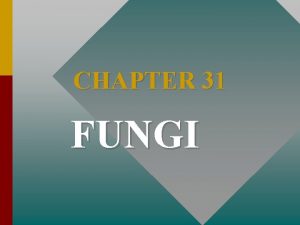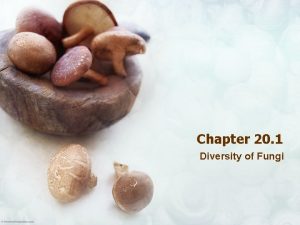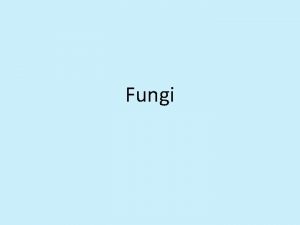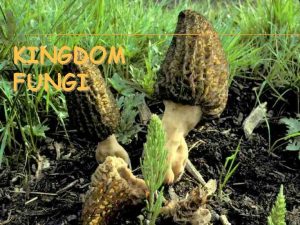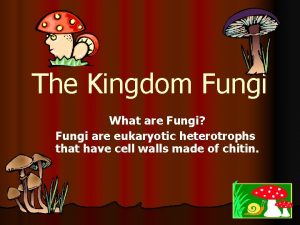Take 5 21612 Where do you find fungi


























































- Slides: 58

Take 5 (2/16/12) • Where do you find fungi? • Are most fungi multicellular or unicellular? • Give an example of a fungus.

Take 5: 2/24/12 • Which hyphae grow horizontally along a surface in order to produce a mycelium? _______ Stolons • What is formed when bread mold reproduces sexually? ______ Zygospores Fungi are classified into groups by their Their spore producing structures _________________

Take 5 (2/24/10) • Study for Vocabulary Quiz!

Take 5 (2/25/10) • What is formed when bread mold reproduces sexually? zygospores • Yeasts usually reproduce asexaully by ______ budding • Puffballs and mushrooms are examples of Club fungi ____.

Take 5 (2/17/12) • Food is digested ____ a fungus’s cells. outside Extracellular digestion This is called ______. • What are the 3 ways that a fungi can reproduce asexually? Fragmentation, budding, or producing spores Sporangium is a case or sac in which spores are • _____ produced.

Take 5: 2/23/12 • Yeasts, truffels, food mold (refrigerator) are Ascomycota examples of _______ • The cell walls of fungi are composed primarily of chitin _______ • Parasitic fungi have developed specialized hyphae that penetrate host cells to absorb nutrients. These hyphae are called Haustoria _________

Chapter 20 Fungi!

Section 20. 1 What is a Fungus?

I. The Characteristics of Fungi • _____ are everywhere, in the air and ____, on damp basement walls, in water gardens, on _____ and sometimes even foods between people’s _____. toes

• This patient presented with a case of a periorbital fungal infection known as mucormycosis, or phycomycosis. Mucormycosis is a dangerous fungal infection usually occurring in the immunocompromised patient, affecting the regions of the eye, nose, and through its growth and destruction of the periorbital tissues, it will eventually invade the brain cavity.

I. The Characteristics of Fungi A. The structure of Fungi • Most fungi are _________. multicellular • Hyphae= threadlike ______ which develop filaments from fungal ______ spores • ______= hyphae that elongate at their tips Mycelium • • and branch extensively to form a _______. network There are different types of _____ in a hyphae mycelium. Ex: Some _____ the funus, some _____ the food source, and other form fungal ____ invade anchor structures. reproductive The _________ of most fungi contain chitin. Cell walls

Inside hyphae • Many types of fungi have cross walls called septa that divide hyphae into individual cells that contain one or more nuclei

Hyphae Functions • The hyphae in a mycelium have different functions ▫ some anchor the fungus ▫ some invade the food source ▫ others form fungal reproductive structures

I. The Characteristics of Fungi B. Inside hyphae • • Septa = cross walls that ______ hyphae divide into individual ______ that contain cells _____ or more nuclei. one ______ are usually porous, allowing Septa ______ and organelles to flow freely. cytoplasm

Inside hyphae • Septa allow cytoplasm, organelles, and nutrients to flow freely • Some fungi consist of hyphae with no septa ▫ There you will see 100’s of nuclei streaming along in a continuous flow of cytoplasm septa

Photograph of an individual with “ringworm”, or tinea capitis of the scalp caused by Microsporum gypseum. II. Adaptations of Fungi Although it is rare, M. gypseum, a natural • Fungi can be _____, cause on foodhumans to harmful soil habitant, can cause tinea _____ cause diseases. usually produces spoil and animals. or. This fungus • The can also plan an important and beneficial a single inflammatory skin lesion which role, they are ______. decomposers has scaly and hair loss, or broken • The breakpatches down complex _____ organic substances hair shafts. into raw materials that other living organisms ________. need

II. Adaptations of Fungi A. How fungi obtain Food heterotrophs and they use a • Fungi are ______, process called _________ Extracellular digestion to • • obtain nutrients. Food is digested _____ a fungus's cells, outside and the digested products are then absorbed. mycelium grows, the more The more a _____ surface are becomes available for _____ nutrient absorption.

How fungi obtain food Key to success: The more a mycelium grows, the more surface area becomes available for nutrient absorption

II. Adaptations of Fungi B. Different Feeding Relationships Food sources • Fungi have different types of _______ • They may be a saprophyte ( _____ decomposers ), a mutualist (_____ symbiotic relationship), or a • parasite (live off a host) Parasitic fungi may reproduce specialized hyphae called ______, which penetrate haustoria and grow into host cells where they directly absorb the host cells’ ______. nutrients

“Fungus among us” decomposers lichen Insect killer Ant = fungi farmers

III. Reproduction in Fungi • A fungus may reproduce _____ or sexually. asexually • Asexually by fragmentation, ______, or budding spores producing _____. A. Fragmentation and Budding • • In fragmentation, pieces of _____ that are hyphae broken off, grow into new mycelia. yeasts The _____ often unicellular fungi called ______ reproduce by a process called budding- a form of asexual reproduction in which _____ occurs mitosis and a new individual pinches off from the parent _____, matures and separates from the parent.

Fragmentation vs. Budding Pieces of hyphae break off a mycelium and grows into a new mycelium Seen in unicellular yeast. Mitosis occurs and new individual pinches off from the parent, matures and separates from the parent

Budding

III. Reproduction in Fungi B. Reproducing by Spores • • • Most fungi produce _____ spores When conditions are favorable a _____ threadlike hyphae emerges and begin to grow forming a new ______. mycelium In some fungi, specialized hyphae grow away from the rest of a mycelium and produce a spore-containing a structure called a ______- a sac or ____ in which sporangium spores are produced. case For most fungi, the specialized reproductive hyphal structures where the fungal _____ are reproduced are usually the only part of aspores fungus you can ______. see produce two types of _____, one by mitosis Most and the other by _____ at different times during spores their life cycle. meiosis

Reproducing by spores • Recall ▫ Spore = reproductive cell that can develop into a new organism • Most fungi produce spores


reproductive hyphal structures are the only part of the fungus you see


III. Reproduction in Fungi C. The Adaptive Advantages of Spores • • • Many adaptive advantages of fungi involve ____ and their _____. spores production First sproangia protect spores until they are ready to be ______. released Second, most fungi produce _____ number large spores of ____ at one time. Producing so many spore increases the germination ____ survival rate that improves the species _____ chances. Fungal spores are ______ and lightweight and can be dispersed by _____, small ______, and animals. wind water



Amanita phalloides • These toxic mushrooms resemble several edible species commonly consumed by humans, increasing the risk of accidental poisoning. • The toxin damages the liver and kidneys; it is often fatally. It is estimated that half a cap is enough to kill a human. • Death occurs 6 -16 days after the poisoning. • http: //en. wikipedia. org/wiki/Amanita_phalloi des

Amanita phalloides • The death cap is native to Europe. • The toxicity is not reduced by cooking, freezing, or drying. • Consumption of the death cap is a medical emergency requiring hospitalization. • Death caps have been reported to taste pleasant. There is a delay in the appearance of symptoms —during which time internal organs are severely, sometimes irreparably, damaged. Initially, symptoms are gastrointestinal in nature and include abdominal pain, with watery diarrhea and vomiting.

Section 20. 2 The Diversity of Fungi

I. Zygomycota • Zygomycotes reproduce _____ by asexually reproducing spores, or sexually by producing another type of spores. hyphae • The _____ of zygomycotes do not have septa that divide them into individual ____. cells ▫ EX: Rhizopus stol 0 nifer (bread mold)

I. Zygomycota A. Growth and Sexual Reproduction • When a Rizopus spore settles on a piece of ____, it germinates and hypae begin to bread _____. Some hyphae called ____ grow stolon grow horizontally along the surface of the bread producing _____. Some other hyphae mycelium form ____ rhizoids that penetrate the food and _____ the mycelium in the bread. anchor Rhizoids secrete ____ enzymes needed for _____ digestion. Extracellular

I. Zygomycota ▫ Asexual reproduction: _____ develop in the spores sporangia, when it splits open _____ hundreds of spores are released. Those that land on moist food germinate _____. B. Producing zygospores • When the conditions become unfavorable the _____ fungus might reproduce sexually. • When zygomycotes reproduce sexually, the produce zygospores- which are thick-walled spores that can withstand bad conditions. • Gametangium= a structure containing a haploid nucleus.


II. Ascomycotes • Ascomycota is the _____ phylum of fungi. largest sac • The yare also called _______ fungus, which refers to the tiny saclike structures called ascus, in which sexual the _____ spores of the fungi develop. • The sexual spore are called _____ ascospores • During sexual reproduction, _______ chains or clusters as asexual spores celled conidia develop. Wind ____, water and animals • _______, ______ disperse these haploid spores.

Ascomycotes • Fungal hyphae grow up form the mycelium and elongate to form conidiophores • Chains or clusters of asexual spores called conidia develop from the tips of conidiophores

Ascomycotes • Phylum Ascomycota (largest phylum) • 30, 000 species • Aka “sac fungi”

II. Yeast Ascomycotes Budding! A. Important Ascomycotes • • • A few types of sac fungi in your refrigerator _____ in the form of blue-green, red, and brown molds on foods decaying _____. Some cause _____ diseases. plant Morels and _______ truffles are two edible members of this phylum Maybe one of the most important is the _____. yeast Yeasts are unicellular _______ fungi that rarely sac produce hyphae and usually reproduce asexually by _____. budding

Important ascomycetes • In fridge, blue-green, red and brown molds on foods • Cause plant disease on farms (i. e. apple scab, ergot of rye) • Not all sac fungi have bad reputation • ex: morels and truffles

II. Ascomycotes ▫ Yeasts are anaerobes and ferment _____ to sugars produce carbon dioxide and ethyl _____. alcohol ▫ They are also important tools for research in ____ genetics because the have large ______. chromosomes

III. Basidiomycotes A. Badidia and basidiospores • Basidiomycotes have _______-shaped hyphae club called basidia – that produce ____ and spores • • give them their common name –club fungi. Spores called ______ basidiospores are produce in basisia during reproduction. A basidiomycote, such as a mushroom _____ has a complex reproductive _____. (pg 539) Life cycle

Basidomycotes • examples: Mushrooms, puffballs, stinkhorns, bird’s nest fungi, bracket fungi

Basidia and basidospores These fungi have club-shaped hyphae known as basidia that produce spores known as “basidiospores ”

IV. Deuteromycotes • These have no _____ stage in their life sexual cycle. A. Diverse deuteromycotes • Deuteromycotes are used in the making of foods _____ jams, soft drinks, and ______. antibiotics

Diverse Deuteromycotes Penicillin (antibiotic) produced from a deuteromycote

Diverse Deuteromycotes • Deuteromycotes are commonly seen growing on fruit • They are used in making soy sauce & blue-veined cheese • Also, they are used to produce citric acid for jams, jellies, soft drinks and tart fruit-flavored candies

V. Mutualism: Mycorrhizae and Lichens A. Mycorrhizae • • Mycorrhiza is a _____ mutualistic relationship in which a fungus lives symbiotically with a plant _____. Most of the _______ that form mycorrhyzae are fungi ______. basidiomycotes The hyphae _____ the absorptive surface increase of the plants _____, and the fungus receives roots _____ nutrients such as _____ and sugars organic amino acids form the plant. About 80 -90 ____ % of all plants species have roots mycorrhizae associated with their _____.

Mycorrhizae • Mycorrhiza = mutualist relationship in which fungus lives symbiotically with plant

Mycorrhizae • Plants with mycorrhizae grow larger and are more productive Ex: orchids will not germinate without symbiotic fungus to provide water and nutrients

VI. Lichen • The orange, green, and black blotches you see on rocks and trees are form of _____. lichens • Lichen is a symbiotic association between a fungus and a photosynthetic green _______ algae or a cyanobacterium. • Lichen need only ______, air, and ____ light minerals to grow, the photosynthetic partner provides the ____ for both organisms food • The fungus, in turn, provides its partner with ____ and _______ water nutrients that it absorbs. • Lichens are _____. pioneers • Lichens live in a variety of _____, and are climates indicators of _____. pollution

Lichens • Orange, Green, Black lichens on rocks • Lichen = symbiotic association between a fungus (ascomycote) & photosynthetic green alga or cyanobacterium • 20, 000 species

Lichens • Lichens are pioneers (the first to colonize a barren area) • They live in arid deserts and the artic tundra where caribou and musk oxen graze on them

Lichens are good indicators of pollution levels because when the pollutants enter the fungus, it kills it, ultimately killing the lichen.

 General characteristics of fungi
General characteristics of fungi Are fungi eukaryotic
Are fungi eukaryotic Club fungi definition
Club fungi definition Take a bus or take a train
Take a bus or take a train Taking things that don't belong to you
Taking things that don't belong to you The more you take the more you leave behind
The more you take the more you leave behind The zero conditional sentences
The zero conditional sentences What do these sentences express
What do these sentences express You take 100 you had kept under your mattress and deposit
You take 100 you had kept under your mattress and deposit What was pundit's mother tongue
What was pundit's mother tongue Rcf culinary
Rcf culinary Sin will take you farther
Sin will take you farther Psalms 1
Psalms 1 Lest we fall
Lest we fall Lest you fall
Lest you fall Lest you fall
Lest you fall Corinthians 10 12
Corinthians 10 12 Lamb of god takes away the sins of the world
Lamb of god takes away the sins of the world I will take revenge on you
I will take revenge on you Pronunciation poem i take it you already know
Pronunciation poem i take it you already know Which community i belong
Which community i belong Take my yoke upon you
Take my yoke upon you I take you to be my lawfully wedded wife
I take you to be my lawfully wedded wife Alive-o songs
Alive-o songs Aodhan king alexander pappas
Aodhan king alexander pappas Which path will you take
Which path will you take You 1
You 1 Lest satan take advantage of us
Lest satan take advantage of us Take the name of jesus with you
Take the name of jesus with you What action would you take
What action would you take Active note taking
Active note taking Youhol
Youhol Can you take ventolin while pregnant
Can you take ventolin while pregnant You say you love the rain
You say you love the rain Agree or disagree questions about life
Agree or disagree questions about life If you think you can you can poem
If you think you can you can poem Tell me what you eat and i shall tell you what you are
Tell me what you eat and i shall tell you what you are I will follow you follow you wherever you go
I will follow you follow you wherever you go Prime factor of 56
Prime factor of 56 Where do you find the marmans
Where do you find the marmans Volume of trapezoidal prism
Volume of trapezoidal prism How to find vertex form
How to find vertex form Main idea vs theme
Main idea vs theme How to.find surface area
How to.find surface area Total surface area vs surface area
Total surface area vs surface area How to find circumference if you have diameter
How to find circumference if you have diameter Slope on a table
Slope on a table Two polygons are
Two polygons are How do you find roots
How do you find roots How do you find roots
How do you find roots What are reference angles
What are reference angles Vertez form
Vertez form Energy level periodic table
Energy level periodic table 9-3 area and perimeter of composite figures
9-3 area and perimeter of composite figures Range of grouped data
Range of grouped data What is the absolute deviation
What is the absolute deviation Where do you find the number of protons
Where do you find the number of protons Mean of absolute deviation
Mean of absolute deviation How do you find the perimeter of the base of a pyramid
How do you find the perimeter of the base of a pyramid
